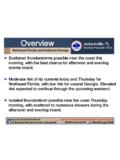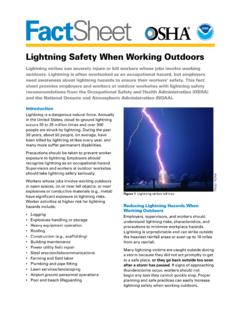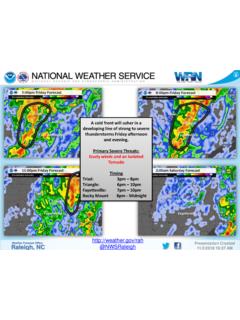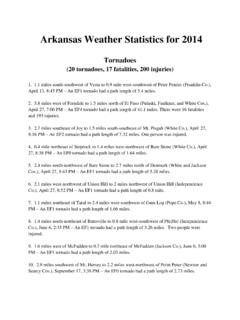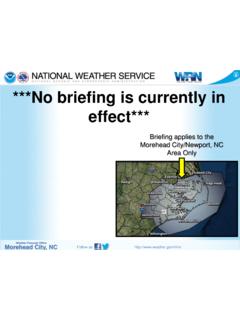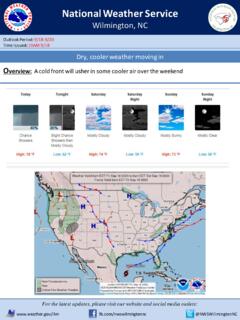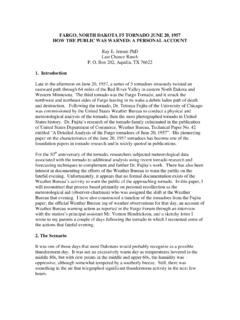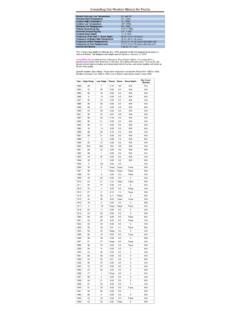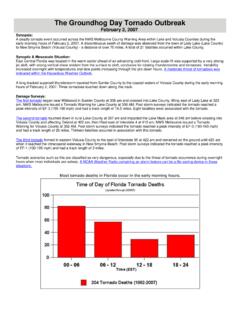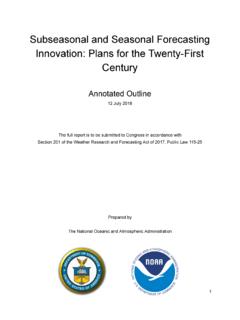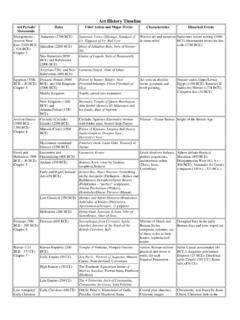Transcription of Texas Hurricane History - National Weather Service
1 Texas Hurricane History David Roth National Weather Service Camp Springs, MD Table of Contents Preface 3 Climatology of Texas Tropical Cyclones 4 List of Texas Hurricanes 8 Tropical Cyclone Records in Texas 11 Hurricanes of the Sixteenth and Seventeenth Centuries 12 Hurricanes of the Eighteenth and Early Nineteenth Centuries 13 Hurricanes of the Late Nineteenth Century 16 The First Indianola Hurricane - 1875 19 Last Indianola Hurricane (1886)- The Storm That Doomed Texas Major Port 22 The Great Galveston Hurricane (1900) 27 Hurricanes of the Early Twentieth Century 29 Corpus Christi s Devastating Hurricane (1919) 35 San Antonio s Great Flood 1921 37 Hurricanes of the Late Twentieth Century 45 Hurricanes of the Early Twenty-First Century 65 Acknowledgments 71 Bibliography 72 Preface Every year, about one hundred tropical disturbances roam the open Atlantic Ocean, Caribbean Sea, and Gulf of Mexico.
2 About fifteen of these become tropical depressions, areas of low pressure with closed wind patterns . Of the fifteen, ten become tropical storms, and six become hurricanes. Every five years, one of the hurricanes will become reach category five status, normally in the western Atlantic or western Caribbean. About every fifty years, one of these extremely intense hurricanes will strike the United States, with disastrous consequences. Texas has seen its share of Hurricane activity over the many years it has been inhabited. Nearly five hundred years ago, unlucky Spanish explorers learned firsthand what storms along the coast of the Lone Star State were capable of.
3 Despite these setbacks, Spaniards set down roots across Mexico and Texas and started colonies. Galleons filled with gold and other treasures sank to the bottom of the Gulf, off such locations as Padre and Galveston Islands. Over time, French settlers began colonies in eastern sections of the state. Finally, Americans came into play. Over the long coast of Texas , many settlements were founded over the centuries. Some disappeared almost as soon as they began due to the viciousness of these equinoctial storms. As they moved inland, flooding rains invaded interior sections of the state, causing massive floods in east Texas and the Balcones Escarpment.
4 In olden times, hurricanes were named after religious holidays or places they struck. Galveston and Indianola have major hurricanes which bear their names. All names found in this document were found during research; none were ascribed by the author. From 1950 onward, naming has been the duty of those who forecast hurricanes in Washington, , before it became the role of the National Hurricane Center, in West Miami, in 1958. This document attempts to put into one source all of the damaging storms that have ever been known to impact the Lone Star State. It is highly likely that some storms were missed; these will be added in later editions.
5 Disputes between different sources on the same storm, from 1837 onward, were usually settled by newspapers at the time. The information with the most sources normally won out. This chronology is important for those who inhabit Texas , or are interested in the state s History . More hurricanes will strike Texas over the coming years. Learning what happened in past storms can help to prepare you for the future. If the past is ignored, mistakes made in previous storms are likely to occur again. 3 Climatology of Texas Tropical Cyclones Since we cannot prevent hurricanes, the next best thing is to know what they can do and be prepared.
6 Those that do not study History are doomed to repeat it, which can be deadly during Hurricane season. Frequency. The frequency of hurricanes in along any fifty mile segment of the Texas coast is one about every six years. Annual probabilities of a strike along a fifty mile segment range from 31% at Sabine Pass to 41% around Matagorda Bay. The annual average occurrence of a tropical storm or Hurricane per year is , or 3 per every 4 years. Since 1829, the longest Hurricane -free period for Texas was nearly 10 years: between October 1989 and August 1999. In contrast, one or more hurricanes affected the coast each year from 1885 to 1888. In 1886, four hurricanes struck the Texas coast with the first and last both hitting Sabine Pass.
7 Since the sixteenth century, hurricanes and tropical storms have struck Texas in the time frame between June 2nd and November 5th. The following is a monthly chart of tropical cyclones that have affected the Texas coast since 1850. This list does not include storms cross Mexico from the East Pacific Ocean, like Lidia in 1991, because Pacific storms were rarely documented before 1966. August is the most likely time that a Hurricane or major Hurricane will strike the Lone Star State. The relative lack of storms prior to 1829 is mainly due to sparse population across the study area and few surviving records. Many ships that may have encountered hurricanes took their storm encounters with them to the bottom of the Gulf of Mexico.
8 The following chart lists storm strikes from 1851 decade by decade. It shows that the busiest decade for Texas landfalling tropical cyclones was the 1940 s. The 1880 s and 2000 s are the next most active decades for Texas . 4 Tropical Cyclones Strikes By The Decade Decade Hurricanes Tropical Storms Total 1850's 3 1 4 1860's 4 1 5 1870's 2 4 6 1880's 8 3 11 1890's
9 3 3 6 1900's 4 2 6 1910's 7 1 8 1920's 2 3 5 1930's 5 4 9 1940's 8 6 14 1950's 2 5 7 1960's 3 3 6 1970's 2 7 9 1980's 5 4 9 1990's 1 4 5 2000's 5 5 10
10 Total 64 56 120 Annual average Rainfall. By far, the most serious threat from a tropical cyclone to Texas residents is flooding. And the worst thing about it is that the weaker the system is, the more efficient it is at producing heavy rains and catastrophic flooding. Claudette (1979), Allison (both 2001 and 1989), and Charley (1998) stand out as recent examples of this fact. Amelia (1978) showed that a system can meander around the state for over a week , creating a headache for residents anywhere between the High Plains and Coastal Plain.
